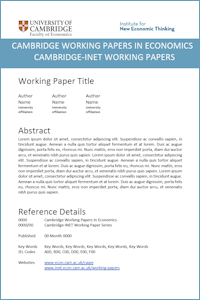
Xiao, J.
Corporate Debt Structure, Precautionary Savings, and Investment Dynamics
CWPE1666
Abstract: Micro-level evidence indicates that firms which substituted bank loans with bond issues during the Great Recession did not experience a large contraction in their total borrowing, but they have been hoarding more cash and investing less than firms that did not substitute. This suggests that firms’ balance sheet adjustment played a key role in the transmission of aggregate shocks. To evaluate the importance of this mechanism in the propagation of the Great Recession, I build a quantitative general equilibrium model of firm dynamics that jointly endogenizes the composition of borrowing on the liability-side, and the portfolio allocation between savings and investment on the asset-side. Bond issuances have lower intermediation costs than bank debt, but the latter can be restructured when firms are in financial distress. In response to a contraction in bank credit supply, firms substitute bank loans with bond issues and thus become more exposed to the risk of financial distress. This strengthens firms’ precautionary incentive to increase cash holdings at the expense of investment, as they optimally trade-off growth against self-insurance via cash holdings. Model simulations suggest that this “precautionary savings†channel can account for 40 percent of the decline in aggregate investment in the first two years of the Great Recession, and more than one-half of the decline in the following five years.
Author links:
PDF: https://www.econ.cam.ac.uk/research-files/repec/cam/pdf/cwpe1666.pdf 
Open Access Link: https://doi.org/10.17863/CAM.7881
